 |
|---|
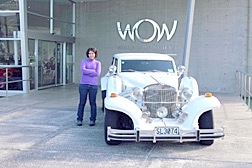 | After an overnight stop in Richmond, we proceeded to Nelton to visit the World of Wearable Art (WOW) and Classic Car Museum. The first exhibit, that fairly jumped out at us, was this Excalibur automobile. This one is a 144 inch wheelbase chassis with a Chevrolet Corvette engine, giving it 0-60 mph time of less than six seconds and a projected top speed of 160 mph. Inside, the ring that Pegah is experimenting with is one of 15 different sizes in gold-plated steel crafted by Thorkild Hansen for LOTR on a jade base created by famed rock sculptor Jeff Beckwith. The elvish writing on the rings was added post-production as a computer generated special effect, so the One Ring will always remain a pure and elegant gold band without markings. |
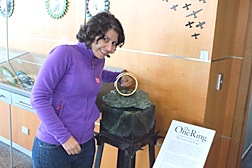 |
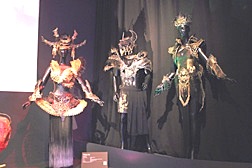 | The World of Wearable Art museum exhibits creations from the annual competition in Nelson and Wellington from April through final judging in September. Most entries are articles of clothing or accessories that range from the outlandish to the truly bizarre. All are actually worn for the judging; the size of the models is one of the specifications for the competition. Some exhibits employ unusual materials, such as zip ties, party balloons, or, in one instance, old suitcases! Garments are judged on originality, creativity, innovation and construction. Selected entries are exhibited in the museum on a dedicated moving runway area and throughout the display of classic cars. |
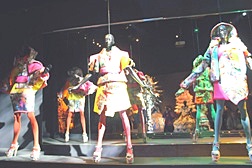 |
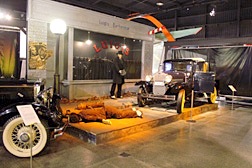 | The classic car exhibits of left- and right hand drive cars, constitute the bulk of the museum. Many of the displays include period or theme decoration, such as this "Roaring Twenties gangster" background for the period vehicles. One example is this 1929 Cadillac Dual Cowl Phaeton, next to a gas light. Cadillac was the first major carmaker in the world to adopt the V8 as its standard powerplant. An improved version, "one of the great eights of the golden age" was introduced in 1928 and is fitted in this car, which also has the innovative "SynchroMesh Transmission. These 1929 cars, built just before the stock market crash and Great Depression of the 1930s, were regarded as the high point of Cadillac luxury.
|
 |
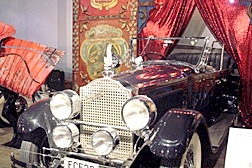 | This black Packard 1927 seven seat "straight 8" touring car and white 1933 Model 1006 V12 roadster coupe demonstrate why Packard-built vehicles were perceived as highly competitive among high-priced luxury American automobiles. In 1931, ten Packards were owned by Japan's Royal Family. Packard came to be known as the number one designer and producer of luxury automobiles in the United States and also had markets in sixty-one other countries. Between 1924 and 1930, Packard was the top-selling luxury brand. In the 1920s, Packard exported more cars than any other in its price class, and in 1930, sold almost twice as many abroad as any other automobile priced over US$2000. |
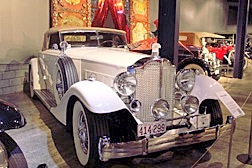 |
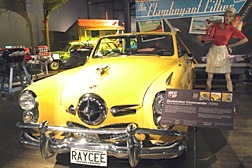 | This extensive collection of historic automobiles brought back memories of cars of my generation. The yellow 1950 Studebaker Commander convertible is very similar in design to the 1948 model my mother owned. They were known as "corn pickers" in Iowa, where virtually everyone was reminded of the resemblance to the agricultural machines. They were also sometimes called "pushmepullyous," from the Doctor Doolittle story, because the rear looked a lot like the front. This red 1959 Plymouth Sport Fury was similar to a 1957 model my father owned, the first year with the swoopy rear fins. It was as easy to drive as wearing a new suit! I liked it so much that my own first car was a Sport Fury in 1964.
|
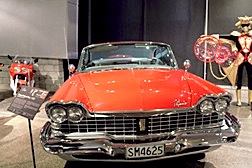 |
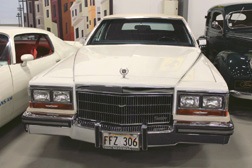 | The design of this 1988 Cadillac Brougham is little changed from the 1987 model I bought in 1992 and eventually gave to my son, David, who promptly traded it for a pickup truck. I found driving the "caddy" to be as effortless as sitting in my living room watching television. I once drove it nonstop (except for gas and meal stops) 1453 miles from Tucson, Arizona, to Long Beach, Mississippi. This Corvette convertible is an example of one I wanted during my Army days but couldn't afford. I bought a similar 1979 model shortly after I retired and extensively restored it, with a new engine, new paint, and new upholstery. It was destroyed by Hurricane Katrina three years later.
|
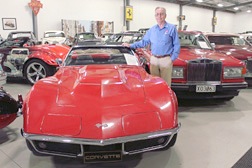 |
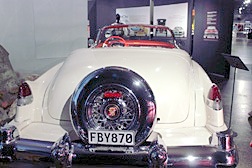 | One of the modifications thought be be "extra cool" during my high school years was the "Continental kit." It consisted of an extended rear bumper and trim to accommodate mounting the spare tire in back of the trunk, here demonstrated on an era Cadillac. The design feature was pioneered by the 1948 Lincoln Continental, hence the name. Of course, to really examine the "Fabulous Fifties," one needs a time machine, and what vehicle could be more suitable than a stainless steel DeLorean DMC-12, the only model produced by the the DeLorean Motor Company? In the words of Doctor Emmett Brown, "The way I see it, if you're gonna build a time machine into a car, why not do it with some style?"
|
 |
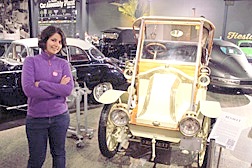 | Pegah posed with some of the cars she really liked, including this meticulously restored left-handed 1908 twin cylinder eight horsepower Renault AX. This model Renault was presented at the London Motor Show in 1908. It was a cheap model - ready to use in different ways, but they were most popular as taxis. She also liked this Messerschmitt Kabinenroller, a design based on the Flitzer invalid carriage designed by Fritz Fend. Fend noticed that able-bodied people were buying Flitzers for use as personal transport and decided to sieze the opportunity. Kabinenroller models set twenty-two closed-circuit speed records for three-wheeled vehicles with small displacements (up to 250 cc).
|
 |
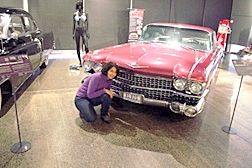 | One car Pegah really admired was this salmon-colored 1959 Cadillac Coupe de Ville, with the huge grille and matching rear deck lid panels, and the twin bullet tail lights on the sharp rear fender fins. The ELVIS license plate reminds one of Elvis' pink Cadillac, but that one was a 1954 Fleetwood Series 60 that was orginally blue. It is on permanent display at the Graceland car museum. Elvis loaned it to his road manager and bodyguard, Joe Esposito, whom he had befriended when they were both in the Army. A smaller car that caught Pegah's fancy is this BMW Isetta, the top-selling single-cylinder car in the world. It is perhaps best known in the United States as Steve Urkel's "nerd car," but Pegah didn't know who Steve Urkel was. |
 |
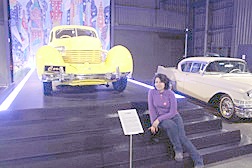 | This 1935 Cord 810/812 is perhaps the company's the best-known model. It has front-wheel drive and independent front suspension. The front drive made the Cord hood distinctively long, earning it the nickname "coffin nose." Without the drive shaft hump, the car was made low enough that runningboards were unneeded. The four-speed semiautomatic transmission was electrically selected. With its clean lines and distinctive styling, the car became instantly popular, but the company failed to anticipate the demand or the production problems involved, and production ceased after only two years. After seeing all these beautiful cars in the entire museum, Pegah decided that she liked them all! |
 |
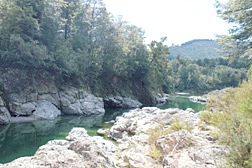 | From Nelson we drove to the Pelorus Bridge site of the filming of the dwarves tumbling down the Forest River in barrels as they escaped the dungeons of King Thranduil in The Hobbit, with the pursuing orcs desperately chasing them. I found the uneven rocks surprisingly difficult to negotiate, and stumbled a number of times. Once I actually lost my footing and fell rather hard, frightening Pegah half to death and narrowly missing a concussion. Here Pegah is exhibiting the liveliness of youth, imitating the elf Taurel as she gracefully bounds from tock to rock. I later told someone that she was nimble as a mountain goat. I meant it as a compliment, but she didn't like being compared to a goat.
|
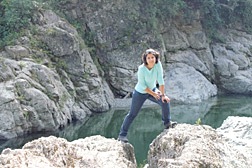 |
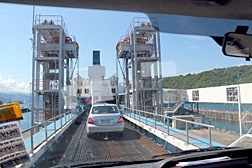 | We had been hurrying all day because we absolutely had to make the Arahura Interislander ferry before 10:30 PM, and wanted to leave at 6:45 PM on the Aratere. Fortunately, The Arahura was still operating on its summer schedule at 2:30. We arrived just as it was getting ready to sail, prompting the ticket lady to scold us for being late, but getting on board anyway. I believe we were the last vehicle. We left our campervan on the vehicle deck and headed topside for the three hour trip to Wellington, as the ship slid away from the dock and made its way past the many islands of Curious Cove into the Cook Strait. Pegah held my hat to keep it from blowing away as I photographed her on the observation deck.
|
 |
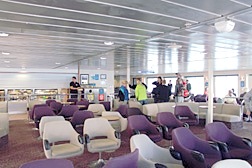 | Arahura is a Maori word meaning "pathway to dawn." The Arahura River on the South Island's West Coast is the country's main source of New Zealand jade (also known as New Zealand greenstone or pounamu). The Maori called the South Island "Te Wai Pounamu" - "the place of the greenstone." The Arahura carriers up to 550 passengers and has been sailing across the Cook Strait since 1983. With a bar and food court, Arahura offers extensive food and beverage facilities. Here we took advantage of the meal vouchers given to us by Cameron at the Abba Gardens Hotel. In addition to the interior lounge, the ship has external observation decks and lounges, wi-fi Internet, and even a cinema. |
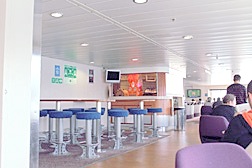 |
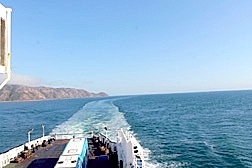 | The Cook Strait lies in a deep trench between the irregular coasts of North and South Island, but the Curious Cove area of Queen Charlotte Sound and Fitzroy Bay at the entrance to Wellington harbor is relatively shallow. The route of the ferries, the Bluebridge and Interislander lines, follows a well-defined but meandering course between Picton and Wellington. During our trip, we caught up with, and passed, one of the Bluebridge ships, which I first mistook for a sidewheel paddlewheel boat because of the curved markings on the side. When we arrived in Wellington, we saw our sister ship, the Kaitaki, distinguishable by her orange lifeboats, tied up for the evening.
|
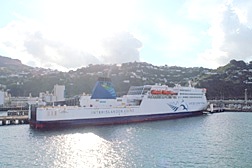 |
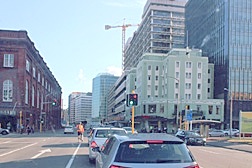 | Wellington is the capital city and second most populous urban area of New Zealand, a blend of old and new buildings and infrastructure, with a population of almost 400,000. The Wellington urban area comprises four cities: Wellington city, Porirua, Lower Hutt, and Upper Hutt, together known as the Hutt Valley. The 2014 Mercer Quality of Living Survey ranked Wellington 12th in the world. In 2011, Lonely Planet Best in Travel 2011 named Wellington fourth in its Top 10 Cities to Visit in 2011, referring to it as the "coolest little capital in the world." Because of our early departure, we arrived while it was still daylight, and had no problem navigating the Wellington traffic to find our holiday park.
|
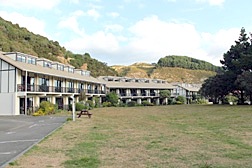 |
| Click here to go to the next page. |
|---|





























































